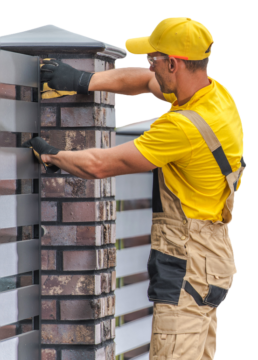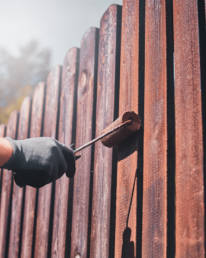Fence rot can and will occur if wooden fences do not receive proper maintenance and care. It is preventable, however. Although wood fencing material brings sophisticated style to any property, the ambiance is quickly swayed if damage occurs. Fence rot is one of the biggest problems facing wood fence owners. Rather than remove the fence and install a different material, learn the best ways to keep the fence in tip-top condition. The following information is a good place to start, covering wood rot and how to prevent this fence common problem.
What is Fence Rot?
Rot occurs as a result of environmental exposures, particularly moisture. It is characterized by deterioration of wood and can lead to holes, discoloration, and collapse of the fence. Dry rot and wet rot are the two types of wood rot.
Wet rot is the most common type of fence rot. This rot occurs when there is too much moisture on the wood. It often occurs at the base of the fence and can be identified quickly since fungal growth usually appears. The fence may even have a musty odor.
Dry rot occurs when a fence is exposed to sunshine and dry, harsh conditions. This causes the wood to dry out so significantly it can crumble in your hands. It becomes hard and discolored as well. Dry rot takes longer than wet rot but is equally devastating and problematic for fence owners.
How to Prevent Fence Rot
Preventative maintenance helps prevent wood rot and that begins with awareness. Be aware of the risks for your specific wood species because different materials have different challenges. Plenty of information about wood species is available online.
Regular staining will not only improve the fence look but also help prevent rot. Apply a protective sealant onto the fence each year when it is stained for double protection and peace of mind. This inexpensive service keeps the fence in good standing -and adds appeal to your property.
Finally, do not skimp on regular fence inspections and cleaning. Keep the fence free of debris and any moisture-prone items. Clearing out the area once or twice each week during summer and spring usually keeps problems at bay. If you notice trouble, fix it as soon as possible to prevent further damage. If the work is out of your league, get on the phone to schedule service with a fence expert.

Need an expert opinion? Talk to our experts today!
When you talk to our experts at Denco Fence Company, we’ll help you compare fence styles, share design ideas, and answer any questions along the way. If you’re looking to build or repair a fence that you and your neighbors are going to love, get a free estimate and let us help bring your project to life.

